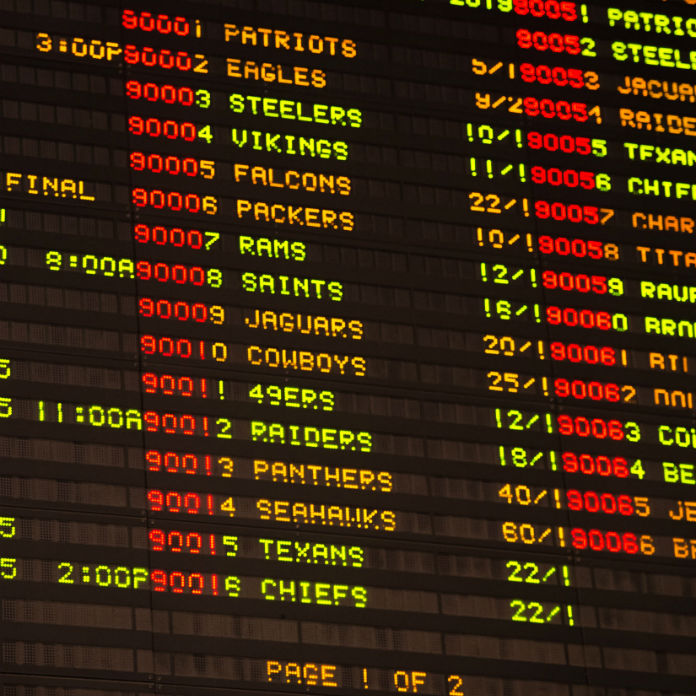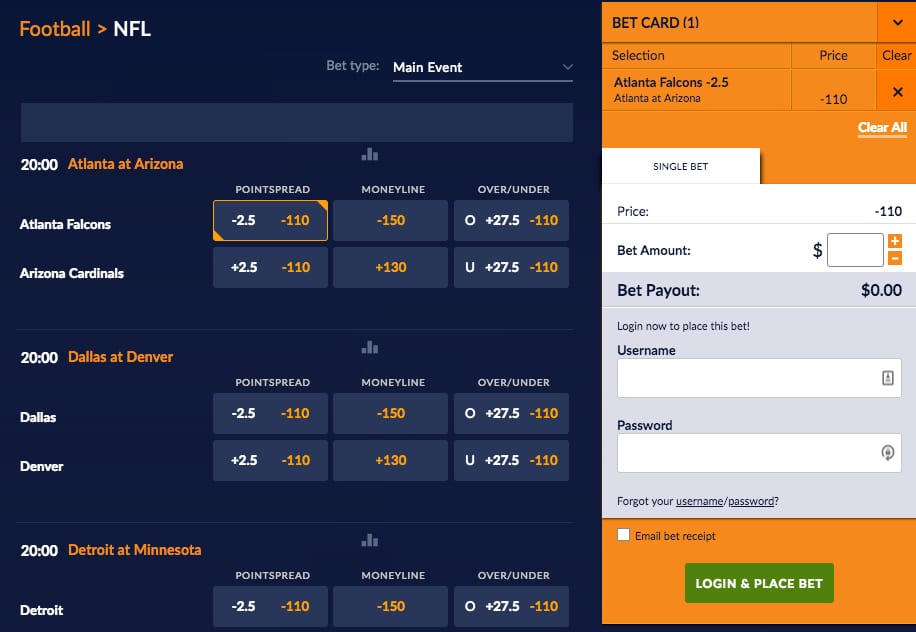Plus And Minus Betting
Reading sports betting odds can seem complicated at first glance.
-110
Below is an example of NFL betting odds taken from an online betting site. In this example you can see Los Angeles is listed at +130 ($100 bet pays $130 plus of course your original wager back) and New England is listed at -150 ($150 bet pays $100). The magic number in sports betting is -110 because it defines the amount required by a sportsbook to earn $100 on either side of most wagers. A bettor must lay $110 to win $100 when wagering on point spreads, which are set by oddsmakers with hopes of getting equal action on both sides. The plus sign in front of the point spread number means that the team will be given the handicap of those points at the end of the game, while the minus sign means that this number of points would be taken from the team from their final score. In American sports betting, the industry standard is the use of the plus sign and the minus sign. PLUS MEANS THE TEAM IS THE UNDERDOG BY THAT NUMBER OF POINTS. MINUS MEANS THE TEAM IS FAVORED BY THAT MANY POINTS. FOR EXAMPLE, OHIO STATE -17 MEANS THEY ARE FAVORED BY 17 POINTS.
11/10

1.91
What do they all mean?
All of the above numbers represent different ways to display betting odds, however they all represent the same thing.
All betting odds represent the implied probability to win a bet. The way that number is displayed is where things can differ.
Types of Betting Odds
There are three main ways to display betting odds:
- American
- Decimal
- Fractional
Each of the odds formats represent a chance of winning, just displayed in a different way.
Most sports betting sites will give you the option in how you display your sports odds, so it is important to understand how to read them.
All sports betting types will have odds attached to them: point spread, money line, total, futures, props, and more.
How to read American odds
In the United States, it is standard to use the American odds format (shocking!). Each bet will always have a plus (+) or minus (-) in front of a number greater than 100.
Take for example how the following moneyline bet odds would be displayed for the following sporting event:
Chicago Bears -196
Washington Redskins +170
Since this is a moneyline bet, these odds represent the implied probability each team has to win the game.
American odds can be broken down into two categories: favorites and underdogs.
How do Plus and Minus odds work?
Favorites Odds
When a bet is a favorite, it means the implied probability (win percentage) is greater than 50%. Favorites will always have a minus (-) sign and will always be “negative odds”. Ex: -150.
Favorite odds can be read as “to win $100”.
Meaning if the odds of a bet were -150, you would need to bet $150 to win $100. Note that you do not need bet in $100 increments.

This same ratio would apply to different bet sizes: Bet $15 to win $10, bet $1.50 to win $1, etc.
If you were to read betting odds of -150 out loud, you would say “minus one fifty”.
Underdog Odds
The other side of American odds are underdogs. Underdogs have an implied probability of less than 50%.
Underdog odds are always represented with a plus sign (+) in front of the number and will always be “positive odds”. Ex: +150.
Underdog odds are interpreted different than favorites. Underdog bets are betting $100 “to win” whatever the odds are.
In the +150 example, you would bet $100 to win $150. Again, you can bet any amount you would like. It doesn’t have to be $100. Ex: bet $10 to win $15, bet $1 to win $1.50, etc.
How to read decimal odds
Decimal odds are the easiest odds type to interpret. They are used by most people outside of America, most notably Europe. The Decimal format are also the easiest odds type to convert to an implied win percentage.
Decimal odds tell you what your return will be given your bet amount (or “stake”).
For example, if you bet $10 on the New York Knicks to win at odds of 2.25, your return (or “total payout”) would be $22.50 if they won.
Return does not take into account your original bet amount. Therefore your profit, or “to win” amount, would be $12.50 ($22.50 return – $10 wager).
Note that the return aspect is the key difference between Decimal and American odds. The Decimal format will tell you your return, while the American format will tell you your “to win” amount.
How to read fractional odds
Fractional odds are simply decimal odds represented as a fraction. For example, 3/1 odds are the decimal equivalent of 4.
The biggest difference between fractional and decimal is that fractional tells you the potential profit while decimal tells you the return.
Going back to the previous example, a $10 bet at 3/1 odds would represent $30 in profit.
A $10 bet at the equivalent odds of 4 in decimal format would return $40. Subtracting your $10 bet from the return would give you your profit of $30.
Fractional odds can be read as the first number being the potential profit while the second number is the amount you will need to risk for that profit.
For example, fractional odds of 23/20 would represent a bettor needing to risk $20 in order to profit $23.
Fractional odds are most common in horse racing and futures markets.
Related: Find more sports betting guides here

Reading sports betting odds can seem complicated at first glance.
-110
11/10
1.91
Plus And Minus Games For Kids
What do they all mean?
All of the above numbers represent different ways to display betting odds, however they all represent the same thing.
All betting odds represent the implied probability to win a bet. The way that number is displayed is where things can differ.
Types of Betting Odds
There are three main ways to display betting odds:
- American
- Decimal
- Fractional
Each of the odds formats represent a chance of winning, just displayed in a different way.
Most sports betting sites will give you the option in how you display your sports odds, so it is important to understand how to read them.
All sports betting types will have odds attached to them: point spread, money line, total, futures, props, and more.
How to read American odds
In the United States, it is standard to use the American odds format (shocking!). Each bet will always have a plus (+) or minus (-) in front of a number greater than 100.
Take for example how the following moneyline bet odds would be displayed for the following sporting event:
Chicago Bears -196
Washington Redskins +170
Since this is a moneyline bet, these odds represent the implied probability each team has to win the game.
American odds can be broken down into two categories: favorites and underdogs.
How do Plus and Minus odds work?
Favorites Odds
When a bet is a favorite, it means the implied probability (win percentage) is greater than 50%. Favorites will always have a minus (-) sign and will always be “negative odds”. Ex: -150.
Favorite odds can be read as “to win $100”.
Meaning if the odds of a bet were -150, you would need to bet $150 to win $100. Note that you do not need bet in $100 increments.
This same ratio would apply to different bet sizes: Bet $15 to win $10, bet $1.50 to win $1, etc.
If you were to read betting odds of -150 out loud, you would say “minus one fifty”.
Underdog Odds
The other side of American odds are underdogs. Underdogs have an implied probability of less than 50%.
Underdog odds are always represented with a plus sign (+) in front of the number and will always be “positive odds”. Ex: +150.
Underdog odds are interpreted different than favorites. Underdog bets are betting $100 “to win” whatever the odds are.
In the +150 example, you would bet $100 to win $150. Again, you can bet any amount you would like. It doesn’t have to be $100. Ex: bet $10 to win $15, bet $1 to win $1.50, etc.
How to read decimal odds
Decimal odds are the easiest odds type to interpret. They are used by most people outside of America, most notably Europe. The Decimal format are also the easiest odds type to convert to an implied win percentage.
Decimal odds tell you what your return will be given your bet amount (or “stake”).
For example, if you bet $10 on the New York Knicks to win at odds of 2.25, your return (or “total payout”) would be $22.50 if they won.
Return does not take into account your original bet amount. Therefore your profit, or “to win” amount, would be $12.50 ($22.50 return – $10 wager).
What Do Betting Odds Mean
Note that the return aspect is the key difference between Decimal and American odds. The Decimal format will tell you your return, while the American format will tell you your “to win” amount.
How to read fractional odds
Fractional odds are simply decimal odds represented as a fraction. For example, 3/1 odds are the decimal equivalent of 4.
The biggest difference between fractional and decimal is that fractional tells you the potential profit while decimal tells you the return.
Going back to the previous example, a $10 bet at 3/1 odds would represent $30 in profit.
A $10 bet at the equivalent odds of 4 in decimal format would return $40. Subtracting your $10 bet from the return would give you your profit of $30.
Fractional odds can be read as the first number being the potential profit while the second number is the amount you will need to risk for that profit.
For example, fractional odds of 23/20 would represent a bettor needing to risk $20 in order to profit $23.
Fractional odds are most common in horse racing and futures markets.
Plus And Minus Betting
Related: Find more sports betting guides here